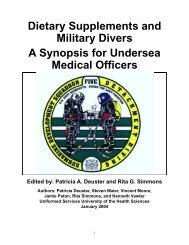Force Health Protection: Nutrition and Exercise Resource Manual
Force Health Protection: Nutrition and Exercise Resource Manual
Force Health Protection: Nutrition and Exercise Resource Manual
Create successful ePaper yourself
Turn your PDF publications into a flip-book with our unique Google optimized e-Paper software.
performed less frequently are found at the top of the pyramid. Level 1<br />
activities include household chores, walking to work, <strong>and</strong> walking up <strong>and</strong><br />
down stairs. Level 2 activities include aerobic exercises <strong>and</strong> participation in<br />
sports <strong>and</strong> recreational activities, such as tennis, hiking, <strong>and</strong> biking. Level 3<br />
consists of strength <strong>and</strong> flexibility exercises, while Level 4 includes sedentary<br />
activities, such as playing computer games <strong>and</strong> watching TV. It is<br />
recommended that you do some Level 1-3 activities each day to get the most<br />
health benefits.<br />
Fuel Used During<br />
<strong>Exercise</strong><br />
Before discussing the various exercise guidelines in<br />
the following chapters, here is an overview of the energy systems used during<br />
exercise. Your body uses the macronutrients you eat (CHO, fats, <strong>and</strong><br />
proteins) to make a chemical called adenosine triphosphate (ATP). You<br />
need ATP to contract your muscles during exercise. ATP can be made two<br />
ways. One way makes ATP without using oxygen <strong>and</strong> is called the<br />
anaerobic energy system. The second way requires oxygen to make ATP<br />
<strong>and</strong> is called the aerobic energy system. Both of these systems (described<br />
below) are required during activity but, depending on the activity, there is a<br />
greater reliance on one system over the other.<br />
Anaerobic Energy System<br />
Activities that depend largely on this energy system last less than 5<br />
minutes or have frequent rest periods. Examples include weight lifting,<br />
sprinting, <strong>and</strong> some interval training routines.<br />
You may have heard about two of the chemicals involved in the<br />
production of ATP without oxygen: creatine phosphate <strong>and</strong> lactic acid.<br />
Creatine phosphate is present in the muscles <strong>and</strong> is used to make ATP<br />
rapidly. Creatine phosphate can make enough ATP to last for 30 seconds<br />
worth of exercise. To try <strong>and</strong> increase the amount of ATP that can be made<br />
from creatine phosphate, some people take creatine supplements. However,<br />
the research is not conclusive as to the benefits of taking creatine <strong>and</strong> the<br />
long-term risks are not known (see Chapter 14). Furthermore, your body<br />
makes creatine <strong>and</strong> it is obtained in the diet from meats. The second chemical<br />
is lactic acid. When maximal or near maximal exercise continues beyond 30<br />
seconds, the muscle must use glucose (a simple CHO) to produce ATP. During<br />
this anaerobic energy process, the by-product lactic acid is formed. Small<br />
amounts of lactic acid can be converted back into glucose <strong>and</strong> then broken<br />
down again to form more ATP. However, as exercise continues, lactic acid<br />
begins to accumulate in the muscles <strong>and</strong> the blood, <strong>and</strong> you begin to fatigue.<br />
If maximal exercise is sustained, fatigue is inevitable within 3-5 minutes.<br />
<strong>Nutrition</strong> <strong>and</strong> <strong>Exercise</strong> <strong>Resource</strong> <strong>Manual</strong> 31


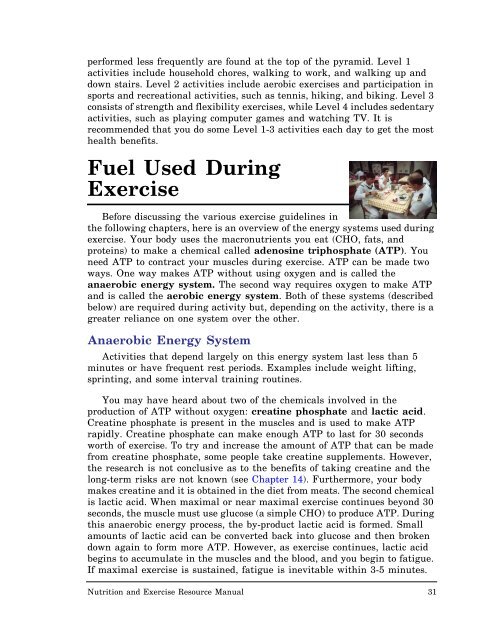

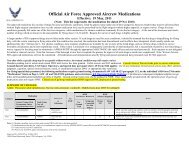

![Body Composition and Military [PDF] - Human Performance ...](https://img.yumpu.com/43269347/1/190x245/body-composition-and-military-pdf-human-performance-.jpg?quality=85)
![Tips for Grocery Shopping [PDF]](https://img.yumpu.com/37447379/1/190x245/tips-for-grocery-shopping-pdf.jpg?quality=85)
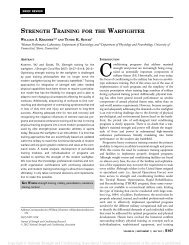
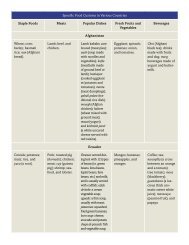
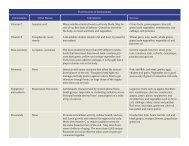
![Synthetic Drugs [PDF] - Human Performance Resource Center](https://img.yumpu.com/37447322/1/190x245/synthetic-drugs-pdf-human-performance-resource-center.jpg?quality=85)
